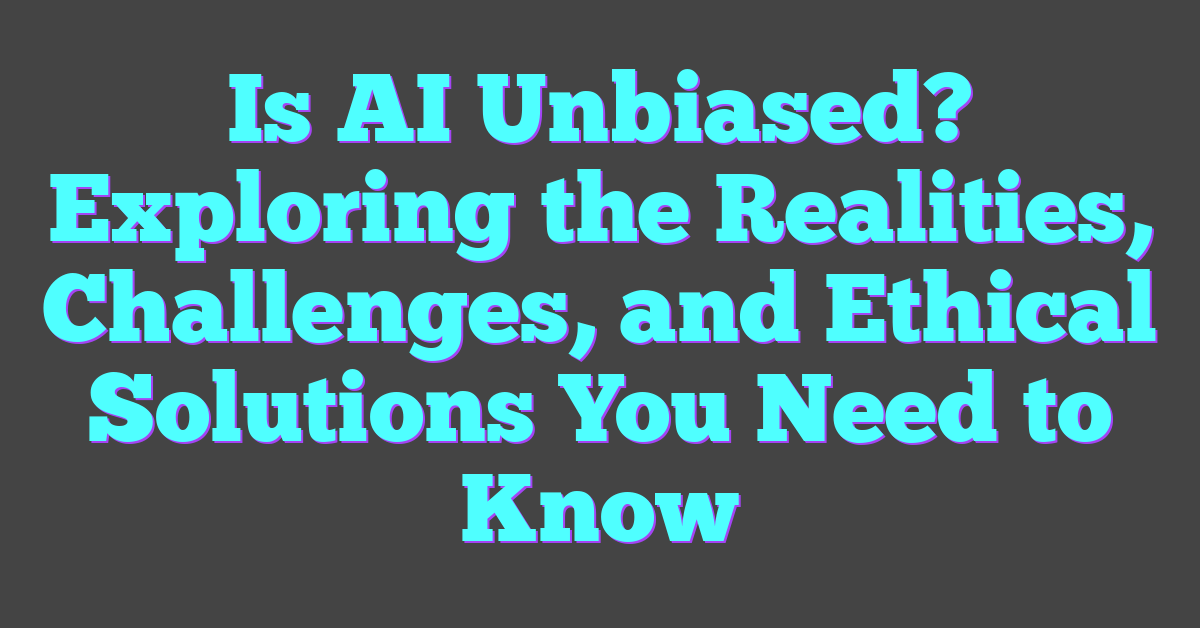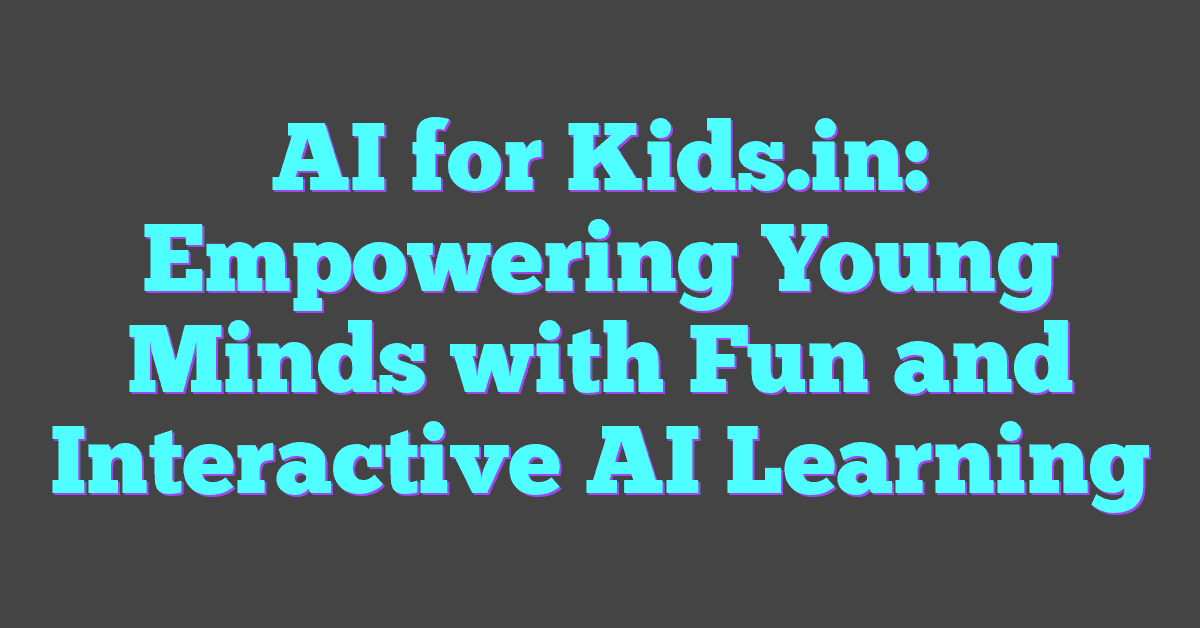Artificial Intelligence (AI) is transforming the world at an astonishing pace, from recommending what to watch next to diagnosing diseases. But with its rise comes a critical question: is AI truly unbiased? Many believe that machines, unlike humans, can operate without prejudice. However, the reality is a bit more complex.
AI systems are created by humans and trained on data that may carry hidden biases. These biases can seep into algorithms, leading to skewed outcomes in everything from hiring practices to criminal justice. Understanding whether AI can be unbiased requires delving into how these systems are built and the data they’re fed.
Understanding AI Bias
Understanding artificial intelligence (AI) bias is crucial to ensuring equitable technology that benefits everyone. It requires a deep dive into what AI bias is and where it comes from.

What is AI Bias?
AI bias occurs when algorithm outputs reflect prejudices present in the training data. These biases affect the algorithm’s decisions and are often unintended. For instance, if an AI model for hiring was trained on past hiring data that favored one gender, it might disproportionately favor that gender in its recommendations. AI bias can emerge in various forms, such as gender, racial, and socioeconomic biases.
Sources of AI Bias
Data
AI models are only as good as the data they are trained on. If training data contains biases, AI systems will likely replicate and even amplify those biases. For example, facial recognition algorithms have struggled with accuracy across different skin tones primarily due to the lack of diverse data.
Algorithm Design
Design choices made during the development of AI systems can introduce or exacerbate biases. Factors like how data is preprocessed, which features are selected, and how performance metrics are defined can all influence the resulting bias.
Human Influence
Humans design, train, and test AI systems, embedding their own biases consciously or unconsciously. Furthermore, decisions about which data to include or exclude depend on human judgment, which can introduce bias. For instance, if a development team lacks diversity, their perspectives and assumptions might skew the AI’s decisions.
Operationalization
How AI systems are deployed and used in real-world scenarios affects their biases. If a system is trained and tested in a specific context but deployed in a different one, unexpected biases can surface. For example, an AI system trained to recognize job candidates in one country might not perform as well in another country due to cultural differences.
Understanding these sources helps in developing more fair and unbiased AI systems, ensuring they serve all users equally.
Consequences of AI Bias
AI bias has significant and far-reaching consequences. Addressing these biases is crucial for creating fair and equitable technology.
Impact on Society
AI bias can perpetuate and even exacerbate existing societal inequalities. For instance, biased algorithms in hiring processes can favor certain demographic groups over others, leading to unequal employment opportunities. Another example is facial recognition technology, which has been shown to have higher error rates for people of color. These inaccuracies can result in wrongful identifications and unjust legal actions. When biases exist in AI systems used for law enforcement, financial services, and healthcare, they can disproportionately affect marginalized communities, leading to systemic discrimination.
Challenges in Technology and Business
AI bias also poses significant challenges for technology and business sectors. Biased AI models can result in flawed decision-making processes, leading to suboptimal outcomes. For example, recommendation systems used in e-commerce might prioritize certain products based on biases in consumer data, causing a negative user experience and reduced sales. Similarly, in finance, biased credit scoring algorithms can unfairly impact loan approval rates for different demographic groups. Addressing these biases requires substantial investments in resources, including diverse data collection, algorithm audits, and continuous monitoring. Businesses risk reputational damage and legal repercussions if they fail to mitigate AI bias in their systems.
Understanding the consequences of AI bias and actively working to eliminate them can pave the way for more equitable, reliable, and inclusive AI technologies.
Addressing AI Bias
Addressing AI bias requires concerted efforts and strategic interventions. Strategies for reducing bias and case studies of effective interventions highlight ways to achieve unbiased AI systems.
Strategies for Reducing Bias
Reducing AI bias involves implementing several strategies. Diverse data collection ensures varied representation within training datasets. When data lacks diversity, biases can get amplified, leading to unfair outcomes. Incorporating data from different demographics and contexts helps mitigate this.
Algorithm audits are another critical approach. Regularly auditing algorithms checks for bias and ensures fairness. Audits can reveal if specific groups are disadvantaged due to biased logic within the algorithm. Researchers use these audits to identify and rectify biases.
Bias can also be reduced by involving interdisciplinary teams in AI development. Teams with diverse backgrounds bring varied perspectives, ensuring that potential biases are identified early. This variety in viewpoints leads to more comprehensive bias detection.
Lastly, transparency in AI decision-making enhances accountability. Transparent AI systems allow users to understand how decisions are made, fostering trust and enabling the identification of hidden biases.
Case Studies of Effective Interventions
Several case studies exemplify effective interventions in addressing AI bias. For example, IBM’s AI Fairness 360 toolkit demonstrates a comprehensive auditing framework. By offering metrics and algorithms to check for bias, it provides a robust means to ensure AI fairness.
Another notable example is the Gender Shades project. This research initiative highlighted disparities in facial recognition technologies across different demographic groups. By specifically analyzing gender and skin type, it pushed for improvements in algorithmic accuracy.
Microsoft’s efforts to reduce bias in AI also offer insights. They developed guidelines and tools for fairness in AI, integrating them into their development processes. This proactive stance has led to more equitable AI systems.
In the healthcare sector, the work of MIT’s Laboratory for Social Machines stands out. They developed models to address bias in health data, ensuring equitable treatment recommendations across diverse patient populations.
Throughout these examples, the common thread is the commitment to fairness and inclusivity. By actively addressing biases, these interventions contribute to more equitable AI applications.
Ethical Considerations
Ethical considerations in AI address fairness, bias reduction, and societal impact. They are essential in shaping trustworthy AI systems.
The Role of Regulations
Regulations govern the ethical deployment of AI. Government bodies and organizations lay down standards to ensure fairness and transparency. For instance, the European Union introduced the General Data Protection Regulation (GDPR), which includes guidelines on automated decision-making and data protection. Compliance with such regulations mitigates bias in AI.
To promote unbiased AI, adherence to these standards is critical. Companies need to account for privacy, security, and discrimination. Regular audits and impact assessments can identify and correct potential biases. There is a strong push for developing international guidelines to harmonize efforts across borders.
Future Implications for AI Development
The future of AI development hinges on ethical practices. Continued innovation, guided by ethical standards, will ensure AI’s positive societal impact. Incorporating ethics into AI starts at the development phase, with diverse data sets and inclusive design processes.
Moreover, interdisciplinary collaboration in AI research can embed fairness into AI systems. Teams comprising ethicists, sociologists, and technologists can provide a holistic approach. Transparency in AI algorithms also builds trust and allows users to understand decision-making processes.
Efforts like IBM’s AI Fairness 360 toolkit and Gender Shades project are stepping stones. They show how ethical considerations can lead to robust, fair AI applications. As AI evolves, embracing ethical guidelines and regulations will be vital for its sustainable growth.
Conclusion
AI’s potential is vast, but so are the risks of bias. Addressing these challenges requires a multi-faceted approach involving diverse data, regular audits, and strong ethical guidelines. Regulations and standards like GDPR play a crucial role in ensuring AI systems are fair and transparent.
Efforts from organizations like IBM and projects like Gender Shades highlight the importance of ethical AI. By embracing these practices, society can harness AI’s benefits while minimizing its risks. The journey towards unbiased AI isn’t simple, but it’s essential for a fair and equitable future.
Frequently Asked Questions
What is AI bias?
AI bias occurs when an artificial intelligence system produces results that are unfairly prejudiced due to erroneous assumptions in the machine learning process.
What are common sources of AI bias?
Common sources of AI bias include biased training data, biased algorithms, and lack of diversity among the development team.
How does AI bias impact society?
AI bias can perpetuate societal inequalities in various sectors like law enforcement, finance, and healthcare.
What are some strategies to reduce AI bias?
Strategies to reduce AI bias include diverse data collection, regular algorithm audits, interdisciplinary collaboration, and transparency in AI systems.
Why is transparency important in AI systems?
Transparency helps in understanding AI decision-making processes, which is crucial for identifying and correcting biases.
How does AI bias affect law enforcement?
AI bias in law enforcement can lead to unjust conclusions, such as disproportionately targeting specific groups based on flawed data.
What ethical considerations are important in AI development?
Important ethical considerations include fairness, accountability, transparency, and inclusivity in AI development and deployment.
What role do regulations play in ethical AI deployment?
Regulations help ensure AI systems are developed and used responsibly, following standards for fairness, accuracy, and privacy, such as GDPR.
Why is interdisciplinary collaboration important in AI development?
Interdisciplinary collaboration brings diverse perspectives that help in identifying and mitigating potential biases in AI systems.
What future implications does ethical AI have on society?
Ethical AI practices can lead to more equitable, transparent, and trustworthy AI systems, promoting positive societal impacts and sustainable growth.
How do projects like IBM’s AI Fairness 360 toolkit contribute to ethical AI?
Projects like IBM’s AI Fairness 360 toolkit provide resources and tools to help developers identify and mitigate biases, promoting fair AI applications.
What is the Gender Shades project?
The Gender Shades project highlights the importance of fairness in AI by evaluating the accuracy of facial recognition systems across different demographic groups.
Why is compliance with standards like GDPR important in AI?
Compliance with standards like GDPR ensures that AI systems respect user privacy, data security, and fairness, fostering trust and accountability.




